MSc Project: Should We Trust Z-Score: UK Private Companies Analysis
VerifiedAdded on 2023/01/11
|31
|8796
|93
Project
AI Summary
This research project investigates the efficacy of the Altman Z-score model in predicting bankruptcy among UK private companies from 2010 to 2018, considering the impacts of the 2008 financial crisis and the Brexit vote. The study employs a quantitative methodology, collecting data from both failed and non-failed companies across various sectors. The research includes data collection from the London Gazette and FAME, followed by financial ratio analysis using DataStream, Hemscott Company Guru, and Thomson One Banker. The project details the development of initial and modified models, assesses type 1 and 2 errors, and employs Mosteller-Wallace analysis to determine the model's predictive accuracy. The empirical analysis focuses on discriminant analysis, variable modification, and model testing to evaluate the Z-score's reliability and its practical implications for stakeholders in the UK private sector. The project aims to provide a comprehensive analysis of the Z-score model's performance in the context of specific economic events, offering insights into its strengths and limitations as a bankruptcy prediction tool.
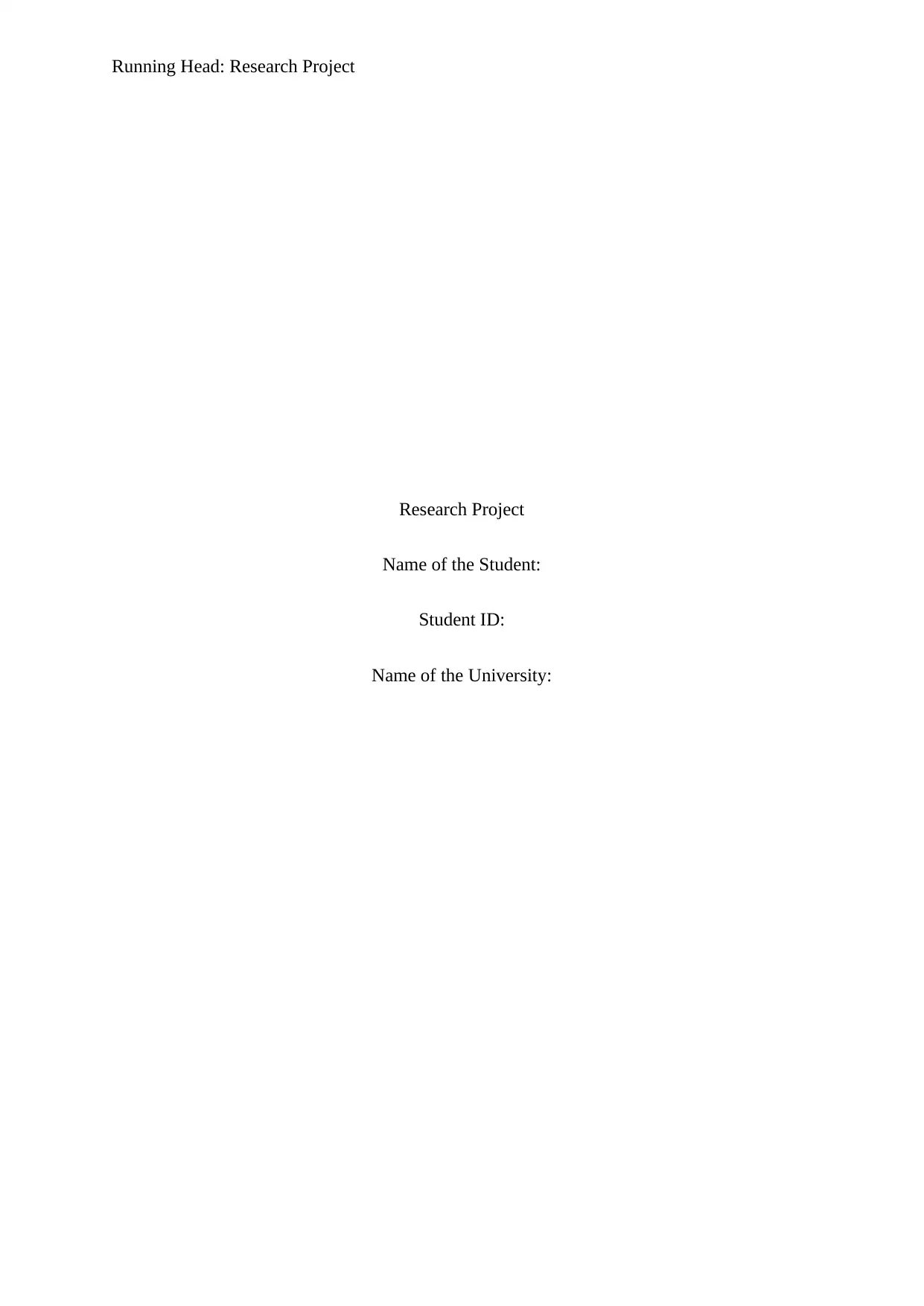
Running Head: Research Project
Research Project
Name of the Student:
Student ID:
Name of the University:
Research Project
Name of the Student:
Student ID:
Name of the University:
Paraphrase This Document
Need a fresh take? Get an instant paraphrase of this document with our AI Paraphraser
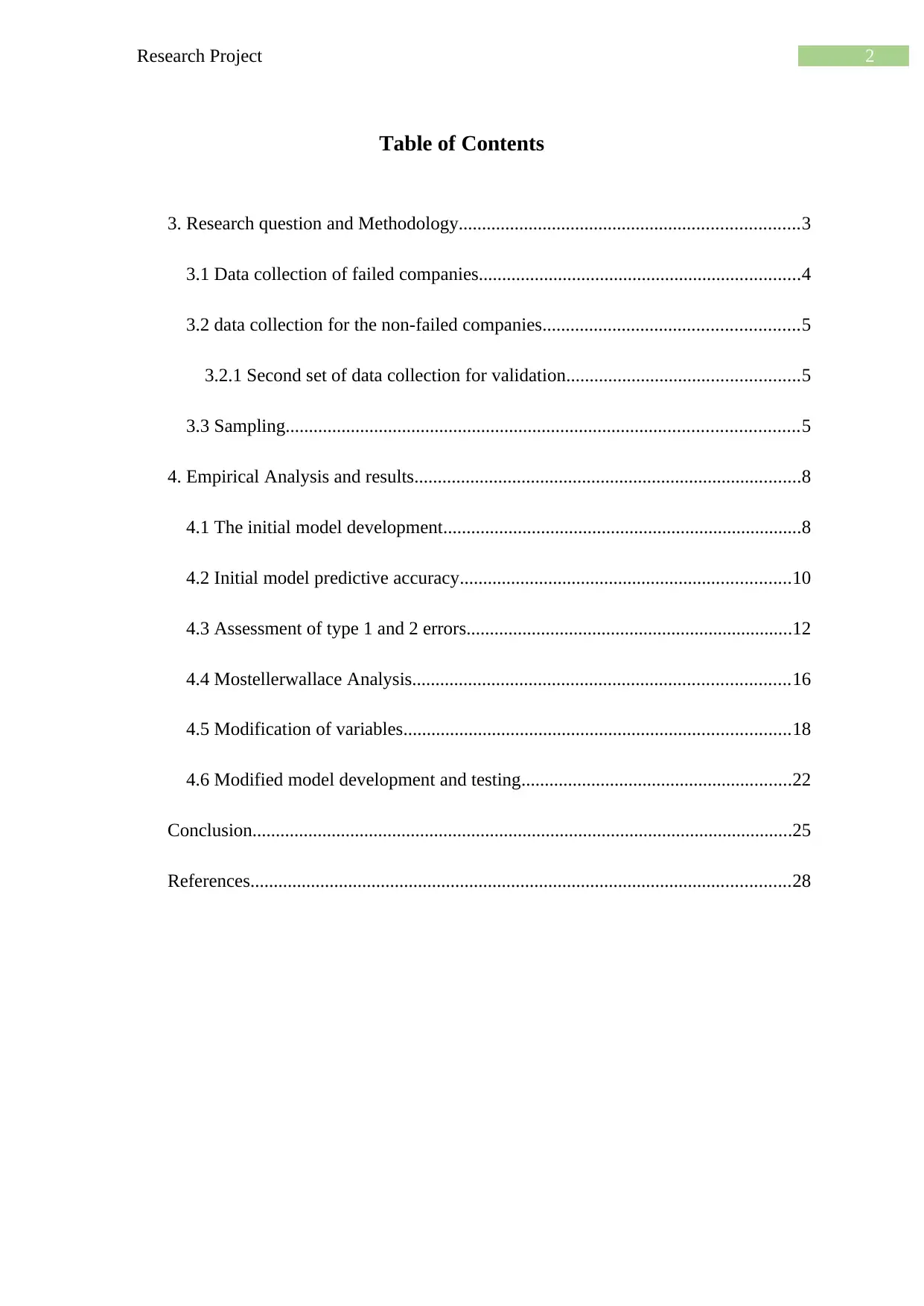
2Research Project
Table of Contents
3. Research question and Methodology.........................................................................3
3.1 Data collection of failed companies.....................................................................4
3.2 data collection for the non-failed companies.......................................................5
3.2.1 Second set of data collection for validation..................................................5
3.3 Sampling..............................................................................................................5
4. Empirical Analysis and results...................................................................................8
4.1 The initial model development.............................................................................8
4.2 Initial model predictive accuracy.......................................................................10
4.3 Assessment of type 1 and 2 errors......................................................................12
4.4 Mostellerwallace Analysis.................................................................................16
4.5 Modification of variables...................................................................................18
4.6 Modified model development and testing..........................................................22
Conclusion....................................................................................................................25
References....................................................................................................................28
Table of Contents
3. Research question and Methodology.........................................................................3
3.1 Data collection of failed companies.....................................................................4
3.2 data collection for the non-failed companies.......................................................5
3.2.1 Second set of data collection for validation..................................................5
3.3 Sampling..............................................................................................................5
4. Empirical Analysis and results...................................................................................8
4.1 The initial model development.............................................................................8
4.2 Initial model predictive accuracy.......................................................................10
4.3 Assessment of type 1 and 2 errors......................................................................12
4.4 Mostellerwallace Analysis.................................................................................16
4.5 Modification of variables...................................................................................18
4.6 Modified model development and testing..........................................................22
Conclusion....................................................................................................................25
References....................................................................................................................28
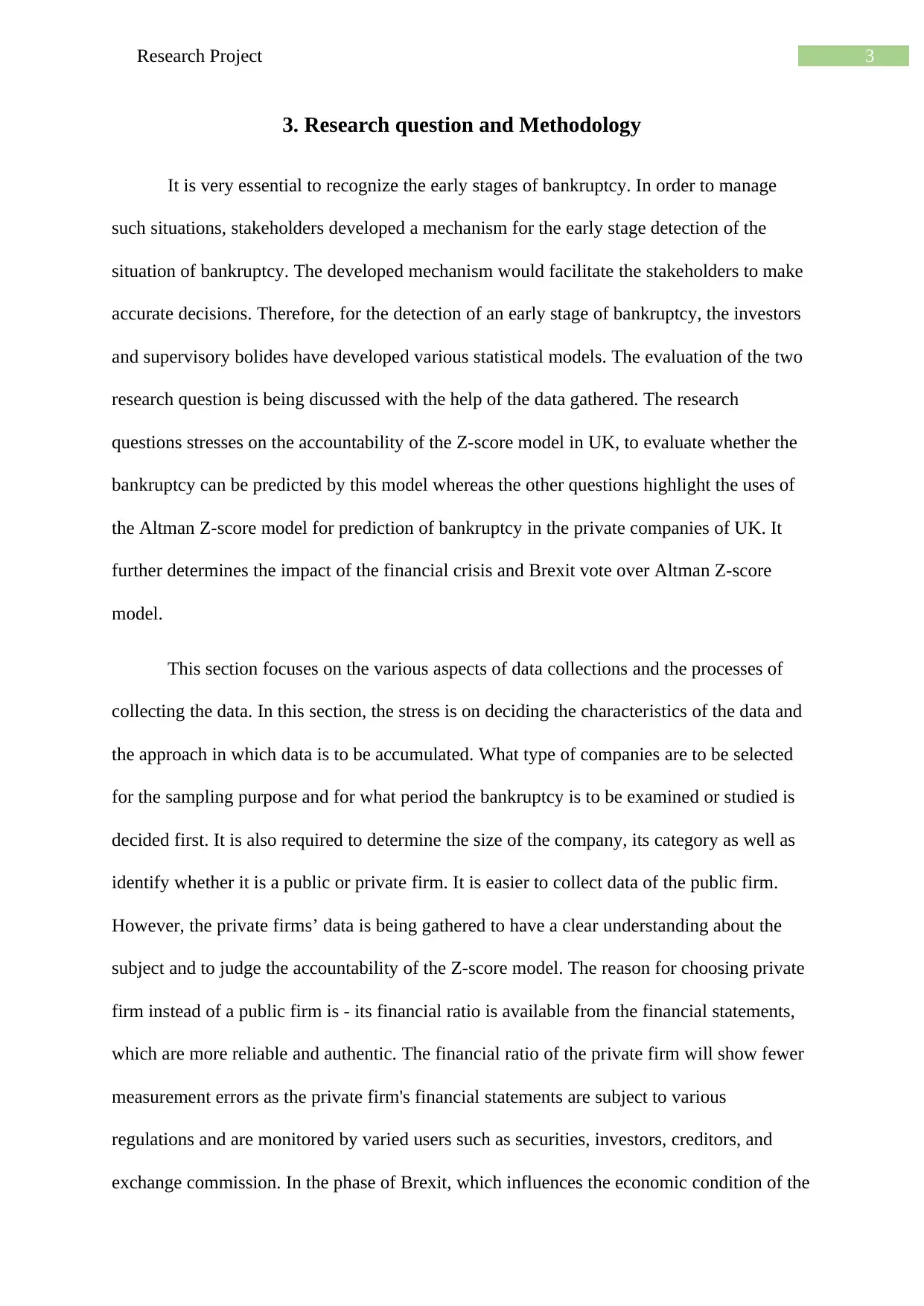
3Research Project
3. Research question and Methodology
It is very essential to recognize the early stages of bankruptcy. In order to manage
such situations, stakeholders developed a mechanism for the early stage detection of the
situation of bankruptcy. The developed mechanism would facilitate the stakeholders to make
accurate decisions. Therefore, for the detection of an early stage of bankruptcy, the investors
and supervisory bolides have developed various statistical models. The evaluation of the two
research question is being discussed with the help of the data gathered. The research
questions stresses on the accountability of the Z-score model in UK, to evaluate whether the
bankruptcy can be predicted by this model whereas the other questions highlight the uses of
the Altman Z-score model for prediction of bankruptcy in the private companies of UK. It
further determines the impact of the financial crisis and Brexit vote over Altman Z-score
model.
This section focuses on the various aspects of data collections and the processes of
collecting the data. In this section, the stress is on deciding the characteristics of the data and
the approach in which data is to be accumulated. What type of companies are to be selected
for the sampling purpose and for what period the bankruptcy is to be examined or studied is
decided first. It is also required to determine the size of the company, its category as well as
identify whether it is a public or private firm. It is easier to collect data of the public firm.
However, the private firms’ data is being gathered to have a clear understanding about the
subject and to judge the accountability of the Z-score model. The reason for choosing private
firm instead of a public firm is - its financial ratio is available from the financial statements,
which are more reliable and authentic. The financial ratio of the private firm will show fewer
measurement errors as the private firm's financial statements are subject to various
regulations and are monitored by varied users such as securities, investors, creditors, and
exchange commission. In the phase of Brexit, which influences the economic condition of the
3. Research question and Methodology
It is very essential to recognize the early stages of bankruptcy. In order to manage
such situations, stakeholders developed a mechanism for the early stage detection of the
situation of bankruptcy. The developed mechanism would facilitate the stakeholders to make
accurate decisions. Therefore, for the detection of an early stage of bankruptcy, the investors
and supervisory bolides have developed various statistical models. The evaluation of the two
research question is being discussed with the help of the data gathered. The research
questions stresses on the accountability of the Z-score model in UK, to evaluate whether the
bankruptcy can be predicted by this model whereas the other questions highlight the uses of
the Altman Z-score model for prediction of bankruptcy in the private companies of UK. It
further determines the impact of the financial crisis and Brexit vote over Altman Z-score
model.
This section focuses on the various aspects of data collections and the processes of
collecting the data. In this section, the stress is on deciding the characteristics of the data and
the approach in which data is to be accumulated. What type of companies are to be selected
for the sampling purpose and for what period the bankruptcy is to be examined or studied is
decided first. It is also required to determine the size of the company, its category as well as
identify whether it is a public or private firm. It is easier to collect data of the public firm.
However, the private firms’ data is being gathered to have a clear understanding about the
subject and to judge the accountability of the Z-score model. The reason for choosing private
firm instead of a public firm is - its financial ratio is available from the financial statements,
which are more reliable and authentic. The financial ratio of the private firm will show fewer
measurement errors as the private firm's financial statements are subject to various
regulations and are monitored by varied users such as securities, investors, creditors, and
exchange commission. In the phase of Brexit, which influences the economic condition of the
⊘ This is a preview!⊘
Do you want full access?
Subscribe today to unlock all pages.

Trusted by 1+ million students worldwide
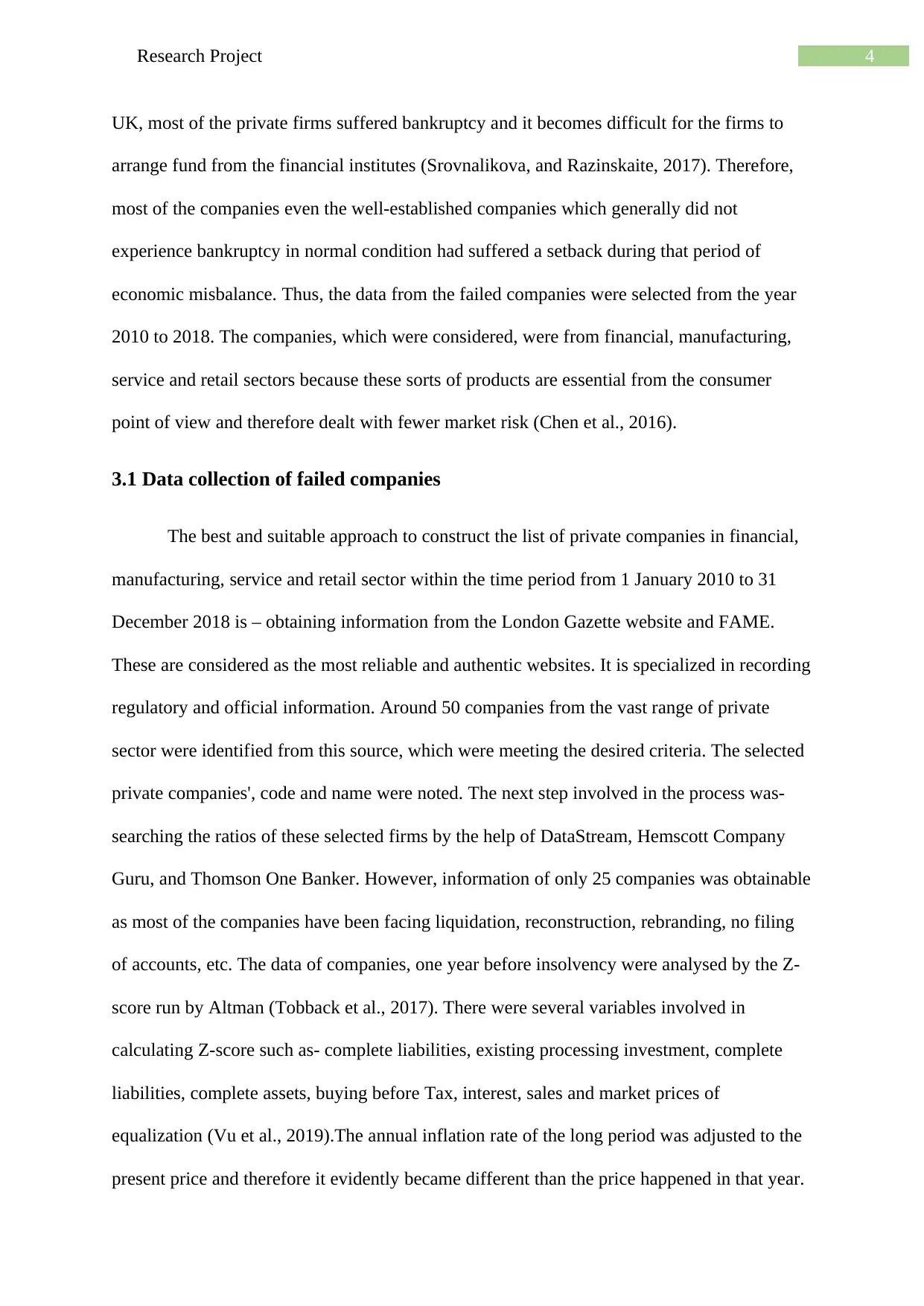
4Research Project
UK, most of the private firms suffered bankruptcy and it becomes difficult for the firms to
arrange fund from the financial institutes (Srovnalikova, and Razinskaite, 2017). Therefore,
most of the companies even the well-established companies which generally did not
experience bankruptcy in normal condition had suffered a setback during that period of
economic misbalance. Thus, the data from the failed companies were selected from the year
2010 to 2018. The companies, which were considered, were from financial, manufacturing,
service and retail sectors because these sorts of products are essential from the consumer
point of view and therefore dealt with fewer market risk (Chen et al., 2016).
3.1 Data collection of failed companies
The best and suitable approach to construct the list of private companies in financial,
manufacturing, service and retail sector within the time period from 1 January 2010 to 31
December 2018 is – obtaining information from the London Gazette website and FAME.
These are considered as the most reliable and authentic websites. It is specialized in recording
regulatory and official information. Around 50 companies from the vast range of private
sector were identified from this source, which were meeting the desired criteria. The selected
private companies', code and name were noted. The next step involved in the process was-
searching the ratios of these selected firms by the help of DataStream, Hemscott Company
Guru, and Thomson One Banker. However, information of only 25 companies was obtainable
as most of the companies have been facing liquidation, reconstruction, rebranding, no filing
of accounts, etc. The data of companies, one year before insolvency were analysed by the Z-
score run by Altman (Tobback et al., 2017). There were several variables involved in
calculating Z-score such as- complete liabilities, existing processing investment, complete
liabilities, complete assets, buying before Tax, interest, sales and market prices of
equalization (Vu et al., 2019).The annual inflation rate of the long period was adjusted to the
present price and therefore it evidently became different than the price happened in that year.
UK, most of the private firms suffered bankruptcy and it becomes difficult for the firms to
arrange fund from the financial institutes (Srovnalikova, and Razinskaite, 2017). Therefore,
most of the companies even the well-established companies which generally did not
experience bankruptcy in normal condition had suffered a setback during that period of
economic misbalance. Thus, the data from the failed companies were selected from the year
2010 to 2018. The companies, which were considered, were from financial, manufacturing,
service and retail sectors because these sorts of products are essential from the consumer
point of view and therefore dealt with fewer market risk (Chen et al., 2016).
3.1 Data collection of failed companies
The best and suitable approach to construct the list of private companies in financial,
manufacturing, service and retail sector within the time period from 1 January 2010 to 31
December 2018 is – obtaining information from the London Gazette website and FAME.
These are considered as the most reliable and authentic websites. It is specialized in recording
regulatory and official information. Around 50 companies from the vast range of private
sector were identified from this source, which were meeting the desired criteria. The selected
private companies', code and name were noted. The next step involved in the process was-
searching the ratios of these selected firms by the help of DataStream, Hemscott Company
Guru, and Thomson One Banker. However, information of only 25 companies was obtainable
as most of the companies have been facing liquidation, reconstruction, rebranding, no filing
of accounts, etc. The data of companies, one year before insolvency were analysed by the Z-
score run by Altman (Tobback et al., 2017). There were several variables involved in
calculating Z-score such as- complete liabilities, existing processing investment, complete
liabilities, complete assets, buying before Tax, interest, sales and market prices of
equalization (Vu et al., 2019).The annual inflation rate of the long period was adjusted to the
present price and therefore it evidently became different than the price happened in that year.
Paraphrase This Document
Need a fresh take? Get an instant paraphrase of this document with our AI Paraphraser
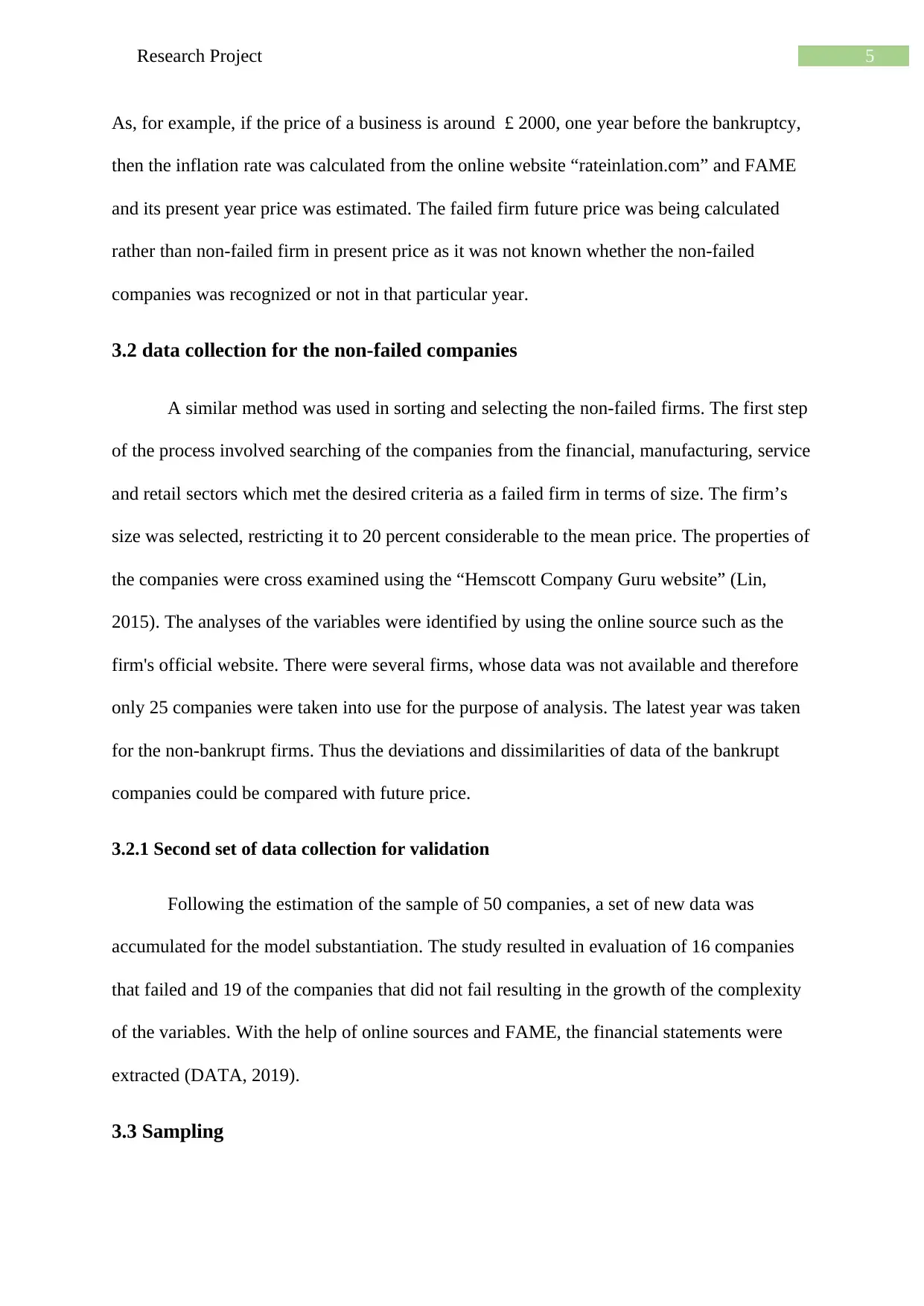
5Research Project
As, for example, if the price of a business is around £ 2000, one year before the bankruptcy,
then the inflation rate was calculated from the online website “rateinlation.com” and FAME
and its present year price was estimated. The failed firm future price was being calculated
rather than non-failed firm in present price as it was not known whether the non-failed
companies was recognized or not in that particular year.
3.2 data collection for the non-failed companies
A similar method was used in sorting and selecting the non-failed firms. The first step
of the process involved searching of the companies from the financial, manufacturing, service
and retail sectors which met the desired criteria as a failed firm in terms of size. The firm’s
size was selected, restricting it to 20 percent considerable to the mean price. The properties of
the companies were cross examined using the “Hemscott Company Guru website” (Lin,
2015). The analyses of the variables were identified by using the online source such as the
firm's official website. There were several firms, whose data was not available and therefore
only 25 companies were taken into use for the purpose of analysis. The latest year was taken
for the non-bankrupt firms. Thus the deviations and dissimilarities of data of the bankrupt
companies could be compared with future price.
3.2.1 Second set of data collection for validation
Following the estimation of the sample of 50 companies, a set of new data was
accumulated for the model substantiation. The study resulted in evaluation of 16 companies
that failed and 19 of the companies that did not fail resulting in the growth of the complexity
of the variables. With the help of online sources and FAME, the financial statements were
extracted (DATA, 2019).
3.3 Sampling
As, for example, if the price of a business is around £ 2000, one year before the bankruptcy,
then the inflation rate was calculated from the online website “rateinlation.com” and FAME
and its present year price was estimated. The failed firm future price was being calculated
rather than non-failed firm in present price as it was not known whether the non-failed
companies was recognized or not in that particular year.
3.2 data collection for the non-failed companies
A similar method was used in sorting and selecting the non-failed firms. The first step
of the process involved searching of the companies from the financial, manufacturing, service
and retail sectors which met the desired criteria as a failed firm in terms of size. The firm’s
size was selected, restricting it to 20 percent considerable to the mean price. The properties of
the companies were cross examined using the “Hemscott Company Guru website” (Lin,
2015). The analyses of the variables were identified by using the online source such as the
firm's official website. There were several firms, whose data was not available and therefore
only 25 companies were taken into use for the purpose of analysis. The latest year was taken
for the non-bankrupt firms. Thus the deviations and dissimilarities of data of the bankrupt
companies could be compared with future price.
3.2.1 Second set of data collection for validation
Following the estimation of the sample of 50 companies, a set of new data was
accumulated for the model substantiation. The study resulted in evaluation of 16 companies
that failed and 19 of the companies that did not fail resulting in the growth of the complexity
of the variables. With the help of online sources and FAME, the financial statements were
extracted (DATA, 2019).
3.3 Sampling
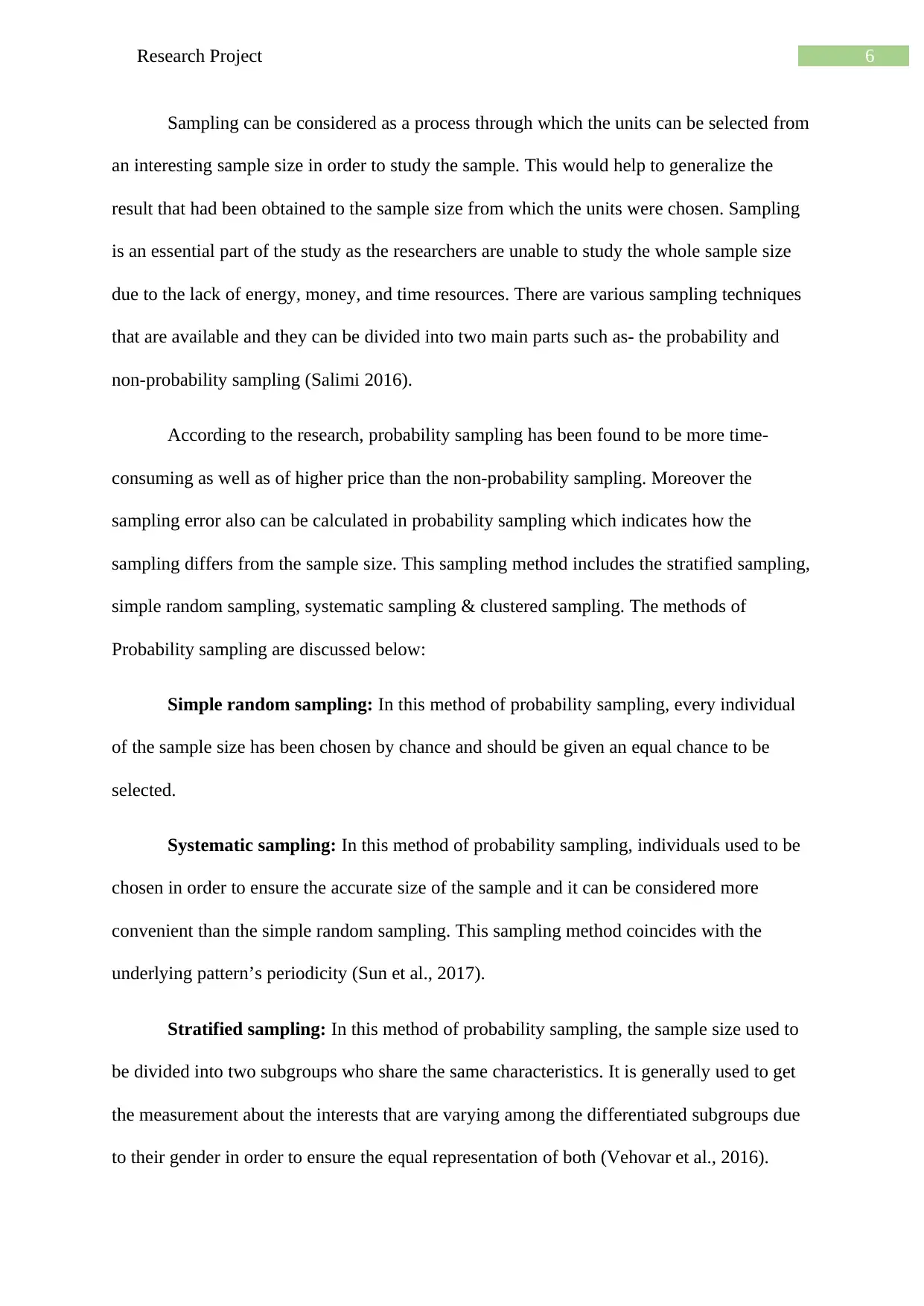
6Research Project
Sampling can be considered as a process through which the units can be selected from
an interesting sample size in order to study the sample. This would help to generalize the
result that had been obtained to the sample size from which the units were chosen. Sampling
is an essential part of the study as the researchers are unable to study the whole sample size
due to the lack of energy, money, and time resources. There are various sampling techniques
that are available and they can be divided into two main parts such as- the probability and
non-probability sampling (Salimi 2016).
According to the research, probability sampling has been found to be more time-
consuming as well as of higher price than the non-probability sampling. Moreover the
sampling error also can be calculated in probability sampling which indicates how the
sampling differs from the sample size. This sampling method includes the stratified sampling,
simple random sampling, systematic sampling & clustered sampling. The methods of
Probability sampling are discussed below:
Simple random sampling: In this method of probability sampling, every individual
of the sample size has been chosen by chance and should be given an equal chance to be
selected.
Systematic sampling: In this method of probability sampling, individuals used to be
chosen in order to ensure the accurate size of the sample and it can be considered more
convenient than the simple random sampling. This sampling method coincides with the
underlying pattern’s periodicity (Sun et al., 2017).
Stratified sampling: In this method of probability sampling, the sample size used to
be divided into two subgroups who share the same characteristics. It is generally used to get
the measurement about the interests that are varying among the differentiated subgroups due
to their gender in order to ensure the equal representation of both (Vehovar et al., 2016).
Sampling can be considered as a process through which the units can be selected from
an interesting sample size in order to study the sample. This would help to generalize the
result that had been obtained to the sample size from which the units were chosen. Sampling
is an essential part of the study as the researchers are unable to study the whole sample size
due to the lack of energy, money, and time resources. There are various sampling techniques
that are available and they can be divided into two main parts such as- the probability and
non-probability sampling (Salimi 2016).
According to the research, probability sampling has been found to be more time-
consuming as well as of higher price than the non-probability sampling. Moreover the
sampling error also can be calculated in probability sampling which indicates how the
sampling differs from the sample size. This sampling method includes the stratified sampling,
simple random sampling, systematic sampling & clustered sampling. The methods of
Probability sampling are discussed below:
Simple random sampling: In this method of probability sampling, every individual
of the sample size has been chosen by chance and should be given an equal chance to be
selected.
Systematic sampling: In this method of probability sampling, individuals used to be
chosen in order to ensure the accurate size of the sample and it can be considered more
convenient than the simple random sampling. This sampling method coincides with the
underlying pattern’s periodicity (Sun et al., 2017).
Stratified sampling: In this method of probability sampling, the sample size used to
be divided into two subgroups who share the same characteristics. It is generally used to get
the measurement about the interests that are varying among the differentiated subgroups due
to their gender in order to ensure the equal representation of both (Vehovar et al., 2016).
⊘ This is a preview!⊘
Do you want full access?
Subscribe today to unlock all pages.

Trusted by 1+ million students worldwide
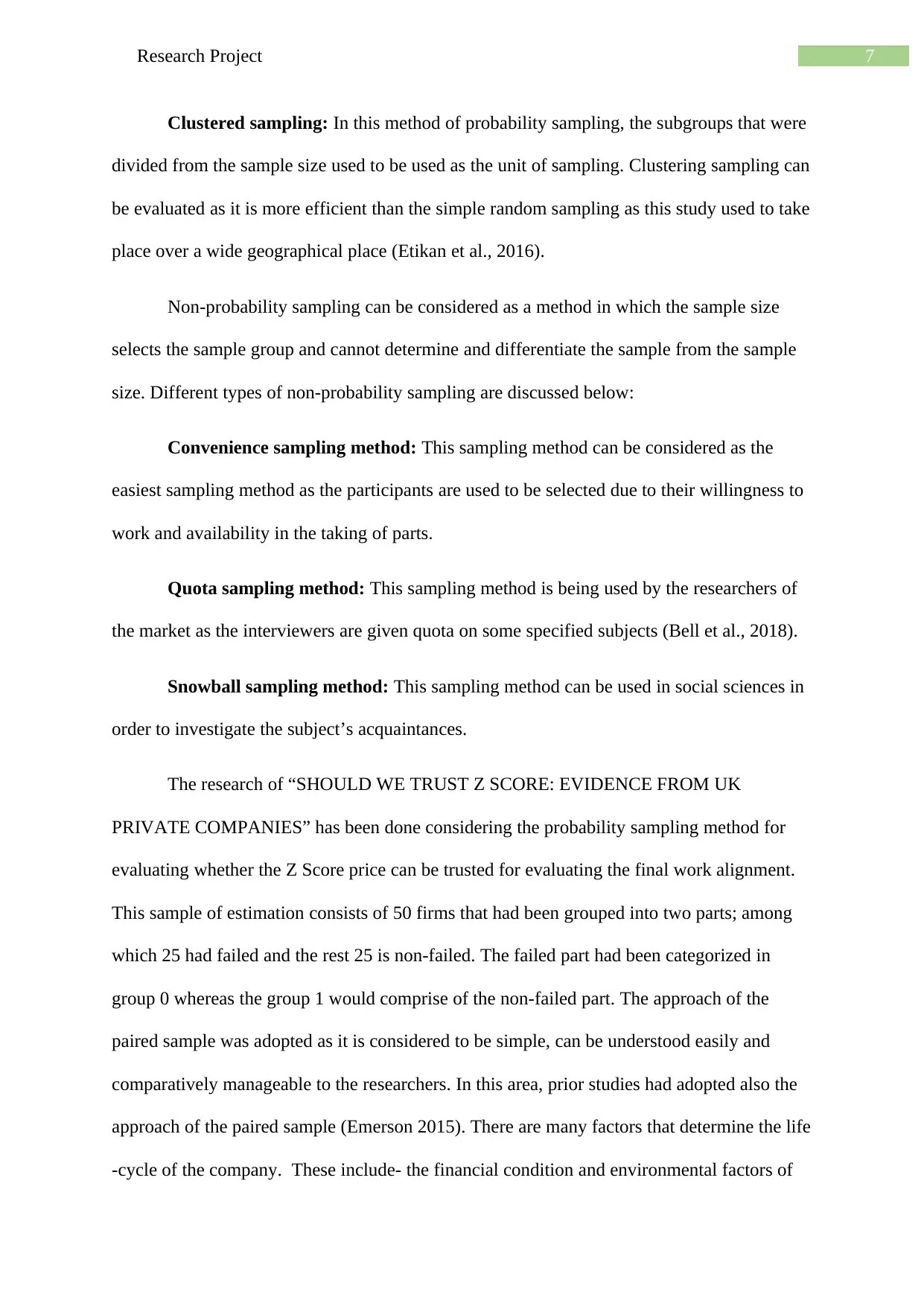
7Research Project
Clustered sampling: In this method of probability sampling, the subgroups that were
divided from the sample size used to be used as the unit of sampling. Clustering sampling can
be evaluated as it is more efficient than the simple random sampling as this study used to take
place over a wide geographical place (Etikan et al., 2016).
Non-probability sampling can be considered as a method in which the sample size
selects the sample group and cannot determine and differentiate the sample from the sample
size. Different types of non-probability sampling are discussed below:
Convenience sampling method: This sampling method can be considered as the
easiest sampling method as the participants are used to be selected due to their willingness to
work and availability in the taking of parts.
Quota sampling method: This sampling method is being used by the researchers of
the market as the interviewers are given quota on some specified subjects (Bell et al., 2018).
Snowball sampling method: This sampling method can be used in social sciences in
order to investigate the subject’s acquaintances.
The research of “SHOULD WE TRUST Z SCORE: EVIDENCE FROM UK
PRIVATE COMPANIES” has been done considering the probability sampling method for
evaluating whether the Z Score price can be trusted for evaluating the final work alignment.
This sample of estimation consists of 50 firms that had been grouped into two parts; among
which 25 had failed and the rest 25 is non-failed. The failed part had been categorized in
group 0 whereas the group 1 would comprise of the non-failed part. The approach of the
paired sample was adopted as it is considered to be simple, can be understood easily and
comparatively manageable to the researchers. In this area, prior studies had adopted also the
approach of the paired sample (Emerson 2015). There are many factors that determine the life
-cycle of the company. These include- the financial condition and environmental factors of
Clustered sampling: In this method of probability sampling, the subgroups that were
divided from the sample size used to be used as the unit of sampling. Clustering sampling can
be evaluated as it is more efficient than the simple random sampling as this study used to take
place over a wide geographical place (Etikan et al., 2016).
Non-probability sampling can be considered as a method in which the sample size
selects the sample group and cannot determine and differentiate the sample from the sample
size. Different types of non-probability sampling are discussed below:
Convenience sampling method: This sampling method can be considered as the
easiest sampling method as the participants are used to be selected due to their willingness to
work and availability in the taking of parts.
Quota sampling method: This sampling method is being used by the researchers of
the market as the interviewers are given quota on some specified subjects (Bell et al., 2018).
Snowball sampling method: This sampling method can be used in social sciences in
order to investigate the subject’s acquaintances.
The research of “SHOULD WE TRUST Z SCORE: EVIDENCE FROM UK
PRIVATE COMPANIES” has been done considering the probability sampling method for
evaluating whether the Z Score price can be trusted for evaluating the final work alignment.
This sample of estimation consists of 50 firms that had been grouped into two parts; among
which 25 had failed and the rest 25 is non-failed. The failed part had been categorized in
group 0 whereas the group 1 would comprise of the non-failed part. The approach of the
paired sample was adopted as it is considered to be simple, can be understood easily and
comparatively manageable to the researchers. In this area, prior studies had adopted also the
approach of the paired sample (Emerson 2015). There are many factors that determine the life
-cycle of the company. These include- the financial condition and environmental factors of
Paraphrase This Document
Need a fresh take? Get an instant paraphrase of this document with our AI Paraphraser
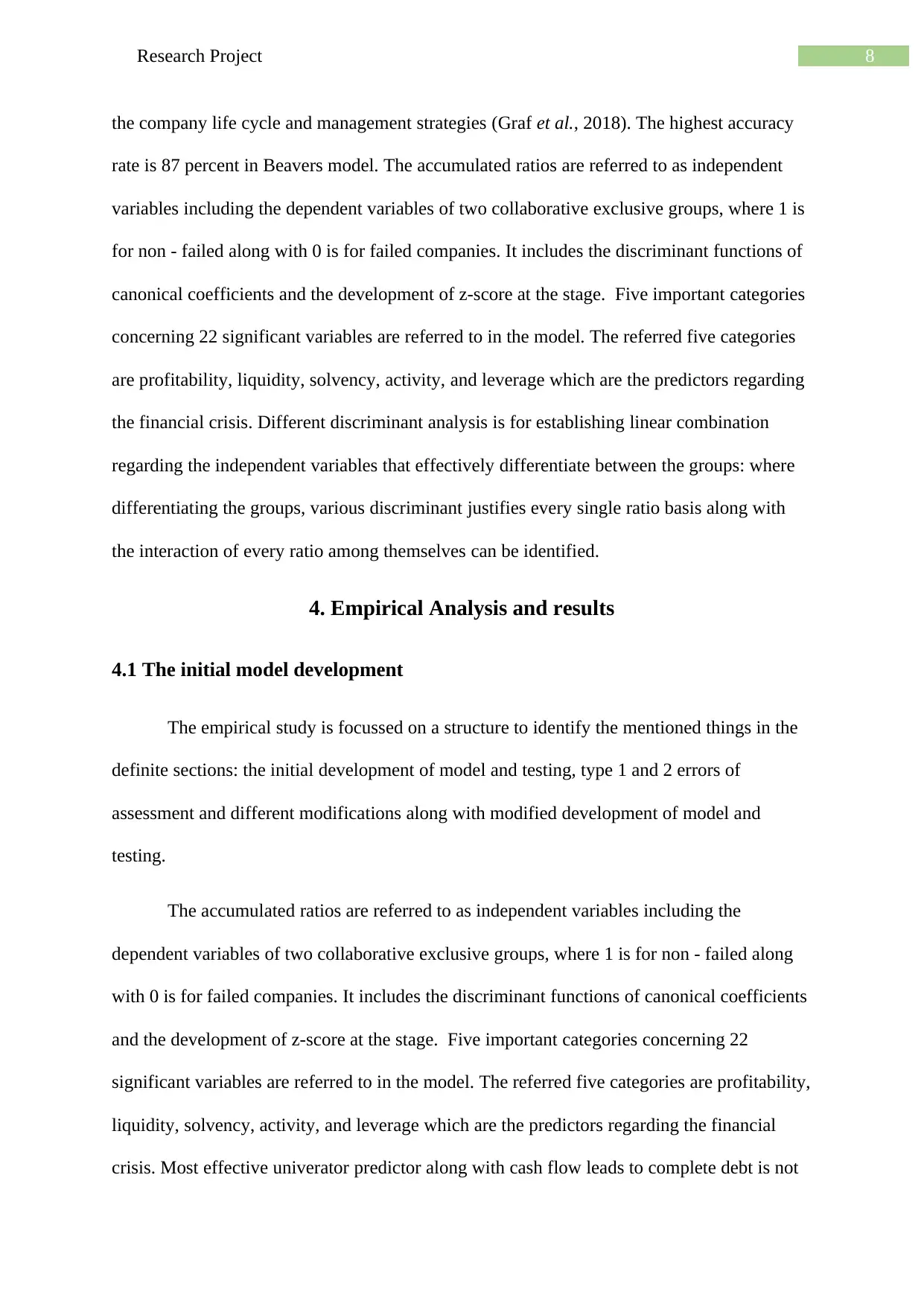
8Research Project
the company life cycle and management strategies (Graf et al., 2018). The highest accuracy
rate is 87 percent in Beavers model. The accumulated ratios are referred to as independent
variables including the dependent variables of two collaborative exclusive groups, where 1 is
for non - failed along with 0 is for failed companies. It includes the discriminant functions of
canonical coefficients and the development of z-score at the stage. Five important categories
concerning 22 significant variables are referred to in the model. The referred five categories
are profitability, liquidity, solvency, activity, and leverage which are the predictors regarding
the financial crisis. Different discriminant analysis is for establishing linear combination
regarding the independent variables that effectively differentiate between the groups: where
differentiating the groups, various discriminant justifies every single ratio basis along with
the interaction of every ratio among themselves can be identified.
4. Empirical Analysis and results
4.1 The initial model development
The empirical study is focussed on a structure to identify the mentioned things in the
definite sections: the initial development of model and testing, type 1 and 2 errors of
assessment and different modifications along with modified development of model and
testing.
The accumulated ratios are referred to as independent variables including the
dependent variables of two collaborative exclusive groups, where 1 is for non - failed along
with 0 is for failed companies. It includes the discriminant functions of canonical coefficients
and the development of z-score at the stage. Five important categories concerning 22
significant variables are referred to in the model. The referred five categories are profitability,
liquidity, solvency, activity, and leverage which are the predictors regarding the financial
crisis. Most effective univerator predictor along with cash flow leads to complete debt is not
the company life cycle and management strategies (Graf et al., 2018). The highest accuracy
rate is 87 percent in Beavers model. The accumulated ratios are referred to as independent
variables including the dependent variables of two collaborative exclusive groups, where 1 is
for non - failed along with 0 is for failed companies. It includes the discriminant functions of
canonical coefficients and the development of z-score at the stage. Five important categories
concerning 22 significant variables are referred to in the model. The referred five categories
are profitability, liquidity, solvency, activity, and leverage which are the predictors regarding
the financial crisis. Different discriminant analysis is for establishing linear combination
regarding the independent variables that effectively differentiate between the groups: where
differentiating the groups, various discriminant justifies every single ratio basis along with
the interaction of every ratio among themselves can be identified.
4. Empirical Analysis and results
4.1 The initial model development
The empirical study is focussed on a structure to identify the mentioned things in the
definite sections: the initial development of model and testing, type 1 and 2 errors of
assessment and different modifications along with modified development of model and
testing.
The accumulated ratios are referred to as independent variables including the
dependent variables of two collaborative exclusive groups, where 1 is for non - failed along
with 0 is for failed companies. It includes the discriminant functions of canonical coefficients
and the development of z-score at the stage. Five important categories concerning 22
significant variables are referred to in the model. The referred five categories are profitability,
liquidity, solvency, activity, and leverage which are the predictors regarding the financial
crisis. Most effective univerator predictor along with cash flow leads to complete debt is not
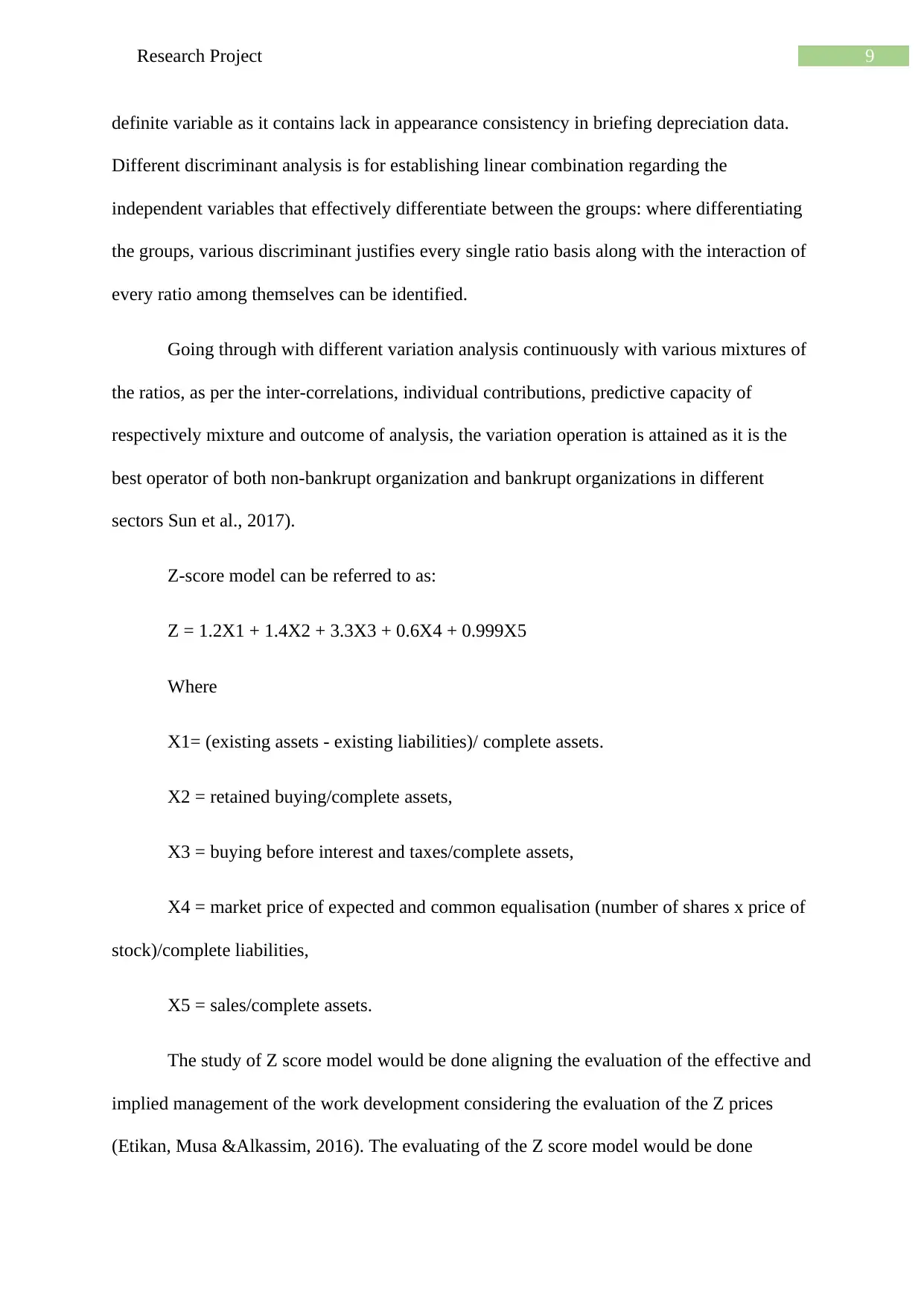
9Research Project
definite variable as it contains lack in appearance consistency in briefing depreciation data.
Different discriminant analysis is for establishing linear combination regarding the
independent variables that effectively differentiate between the groups: where differentiating
the groups, various discriminant justifies every single ratio basis along with the interaction of
every ratio among themselves can be identified.
Going through with different variation analysis continuously with various mixtures of
the ratios, as per the inter-correlations, individual contributions, predictive capacity of
respectively mixture and outcome of analysis, the variation operation is attained as it is the
best operator of both non-bankrupt organization and bankrupt organizations in different
sectors Sun et al., 2017).
Z-score model can be referred to as:
Z = 1.2X1 + 1.4X2 + 3.3X3 + 0.6X4 + 0.999X5
Where
X1= (existing assets - existing liabilities)/ complete assets.
X2 = retained buying/complete assets,
X3 = buying before interest and taxes/complete assets,
X4 = market price of expected and common equalisation (number of shares x price of
stock)/complete liabilities,
X5 = sales/complete assets.
The study of Z score model would be done aligning the evaluation of the effective and
implied management of the work development considering the evaluation of the Z prices
(Etikan, Musa &Alkassim, 2016). The evaluating of the Z score model would be done
definite variable as it contains lack in appearance consistency in briefing depreciation data.
Different discriminant analysis is for establishing linear combination regarding the
independent variables that effectively differentiate between the groups: where differentiating
the groups, various discriminant justifies every single ratio basis along with the interaction of
every ratio among themselves can be identified.
Going through with different variation analysis continuously with various mixtures of
the ratios, as per the inter-correlations, individual contributions, predictive capacity of
respectively mixture and outcome of analysis, the variation operation is attained as it is the
best operator of both non-bankrupt organization and bankrupt organizations in different
sectors Sun et al., 2017).
Z-score model can be referred to as:
Z = 1.2X1 + 1.4X2 + 3.3X3 + 0.6X4 + 0.999X5
Where
X1= (existing assets - existing liabilities)/ complete assets.
X2 = retained buying/complete assets,
X3 = buying before interest and taxes/complete assets,
X4 = market price of expected and common equalisation (number of shares x price of
stock)/complete liabilities,
X5 = sales/complete assets.
The study of Z score model would be done aligning the evaluation of the effective and
implied management of the work development considering the evaluation of the Z prices
(Etikan, Musa &Alkassim, 2016). The evaluating of the Z score model would be done
⊘ This is a preview!⊘
Do you want full access?
Subscribe today to unlock all pages.

Trusted by 1+ million students worldwide
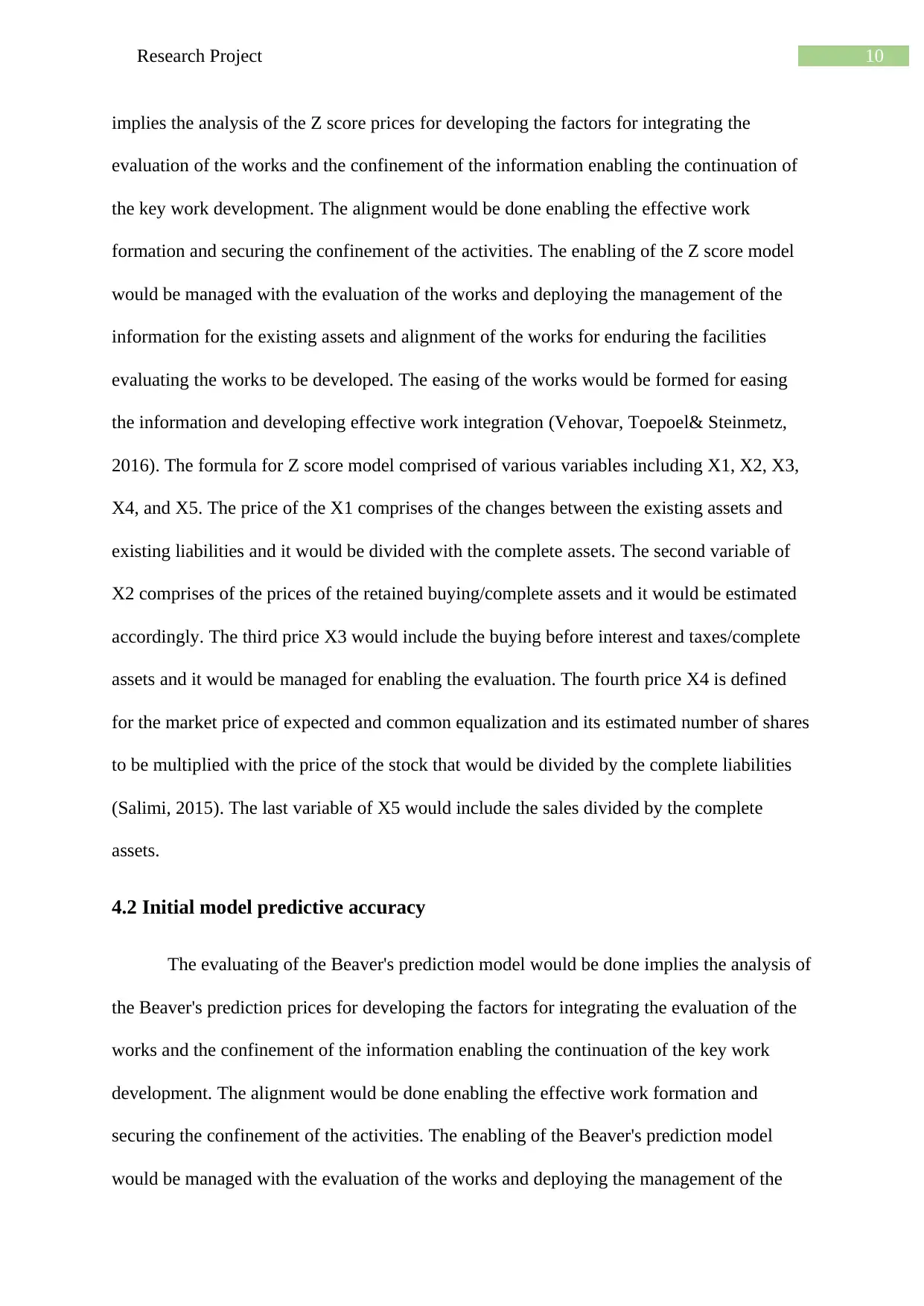
10Research Project
implies the analysis of the Z score prices for developing the factors for integrating the
evaluation of the works and the confinement of the information enabling the continuation of
the key work development. The alignment would be done enabling the effective work
formation and securing the confinement of the activities. The enabling of the Z score model
would be managed with the evaluation of the works and deploying the management of the
information for the existing assets and alignment of the works for enduring the facilities
evaluating the works to be developed. The easing of the works would be formed for easing
the information and developing effective work integration (Vehovar, Toepoel& Steinmetz,
2016). The formula for Z score model comprised of various variables including X1, X2, X3,
X4, and X5. The price of the X1 comprises of the changes between the existing assets and
existing liabilities and it would be divided with the complete assets. The second variable of
X2 comprises of the prices of the retained buying/complete assets and it would be estimated
accordingly. The third price X3 would include the buying before interest and taxes/complete
assets and it would be managed for enabling the evaluation. The fourth price X4 is defined
for the market price of expected and common equalization and its estimated number of shares
to be multiplied with the price of the stock that would be divided by the complete liabilities
(Salimi, 2015). The last variable of X5 would include the sales divided by the complete
assets.
4.2 Initial model predictive accuracy
The evaluating of the Beaver's prediction model would be done implies the analysis of
the Beaver's prediction prices for developing the factors for integrating the evaluation of the
works and the confinement of the information enabling the continuation of the key work
development. The alignment would be done enabling the effective work formation and
securing the confinement of the activities. The enabling of the Beaver's prediction model
would be managed with the evaluation of the works and deploying the management of the
implies the analysis of the Z score prices for developing the factors for integrating the
evaluation of the works and the confinement of the information enabling the continuation of
the key work development. The alignment would be done enabling the effective work
formation and securing the confinement of the activities. The enabling of the Z score model
would be managed with the evaluation of the works and deploying the management of the
information for the existing assets and alignment of the works for enduring the facilities
evaluating the works to be developed. The easing of the works would be formed for easing
the information and developing effective work integration (Vehovar, Toepoel& Steinmetz,
2016). The formula for Z score model comprised of various variables including X1, X2, X3,
X4, and X5. The price of the X1 comprises of the changes between the existing assets and
existing liabilities and it would be divided with the complete assets. The second variable of
X2 comprises of the prices of the retained buying/complete assets and it would be estimated
accordingly. The third price X3 would include the buying before interest and taxes/complete
assets and it would be managed for enabling the evaluation. The fourth price X4 is defined
for the market price of expected and common equalization and its estimated number of shares
to be multiplied with the price of the stock that would be divided by the complete liabilities
(Salimi, 2015). The last variable of X5 would include the sales divided by the complete
assets.
4.2 Initial model predictive accuracy
The evaluating of the Beaver's prediction model would be done implies the analysis of
the Beaver's prediction prices for developing the factors for integrating the evaluation of the
works and the confinement of the information enabling the continuation of the key work
development. The alignment would be done enabling the effective work formation and
securing the confinement of the activities. The enabling of the Beaver's prediction model
would be managed with the evaluation of the works and deploying the management of the
Paraphrase This Document
Need a fresh take? Get an instant paraphrase of this document with our AI Paraphraser
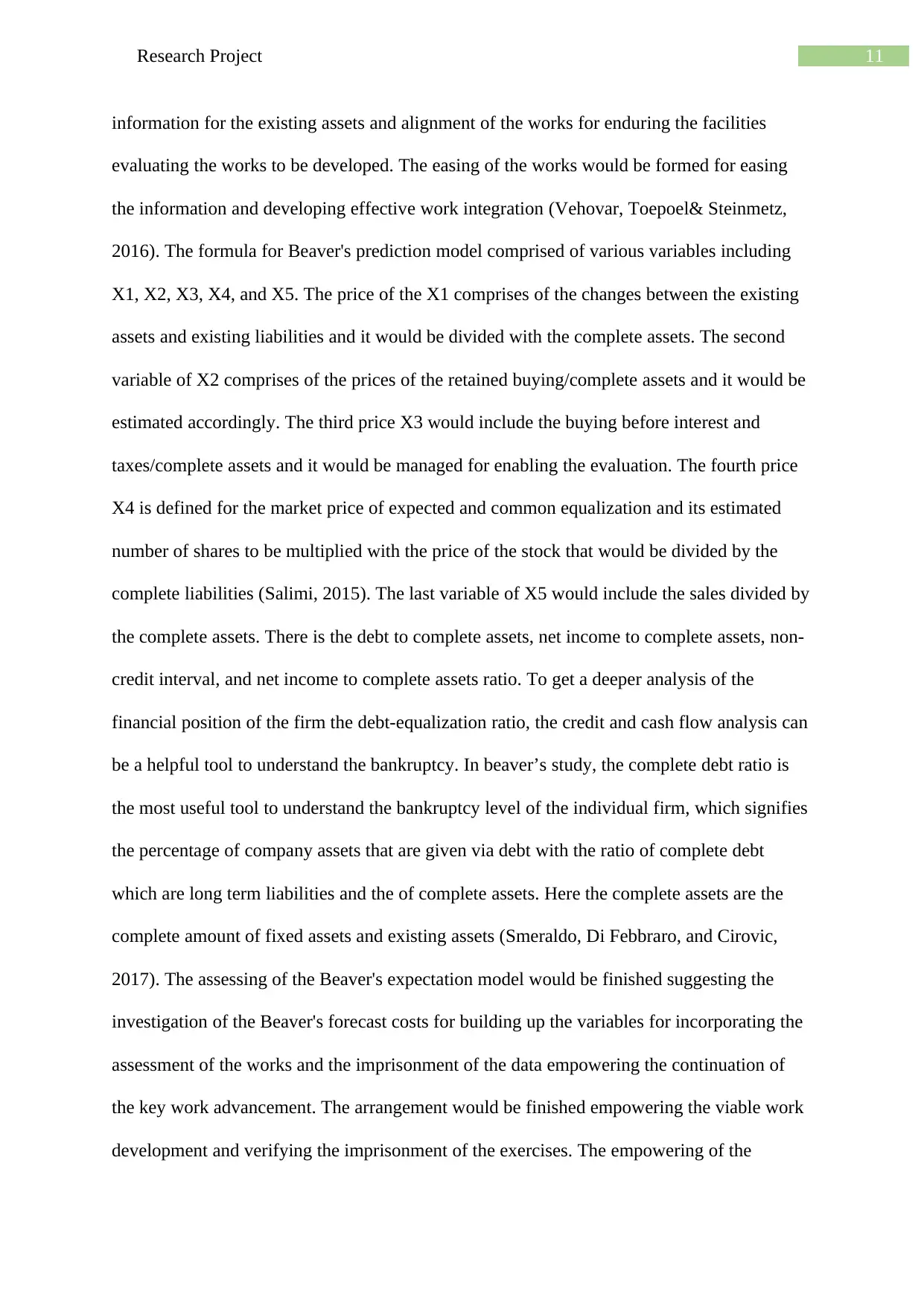
11Research Project
information for the existing assets and alignment of the works for enduring the facilities
evaluating the works to be developed. The easing of the works would be formed for easing
the information and developing effective work integration (Vehovar, Toepoel& Steinmetz,
2016). The formula for Beaver's prediction model comprised of various variables including
X1, X2, X3, X4, and X5. The price of the X1 comprises of the changes between the existing
assets and existing liabilities and it would be divided with the complete assets. The second
variable of X2 comprises of the prices of the retained buying/complete assets and it would be
estimated accordingly. The third price X3 would include the buying before interest and
taxes/complete assets and it would be managed for enabling the evaluation. The fourth price
X4 is defined for the market price of expected and common equalization and its estimated
number of shares to be multiplied with the price of the stock that would be divided by the
complete liabilities (Salimi, 2015). The last variable of X5 would include the sales divided by
the complete assets. There is the debt to complete assets, net income to complete assets, non-
credit interval, and net income to complete assets ratio. To get a deeper analysis of the
financial position of the firm the debt-equalization ratio, the credit and cash flow analysis can
be a helpful tool to understand the bankruptcy. In beaver’s study, the complete debt ratio is
the most useful tool to understand the bankruptcy level of the individual firm, which signifies
the percentage of company assets that are given via debt with the ratio of complete debt
which are long term liabilities and the of complete assets. Here the complete assets are the
complete amount of fixed assets and existing assets (Smeraldo, Di Febbraro, and Cirovic,
2017). The assessing of the Beaver's expectation model would be finished suggesting the
investigation of the Beaver's forecast costs for building up the variables for incorporating the
assessment of the works and the imprisonment of the data empowering the continuation of
the key work advancement. The arrangement would be finished empowering the viable work
development and verifying the imprisonment of the exercises. The empowering of the
information for the existing assets and alignment of the works for enduring the facilities
evaluating the works to be developed. The easing of the works would be formed for easing
the information and developing effective work integration (Vehovar, Toepoel& Steinmetz,
2016). The formula for Beaver's prediction model comprised of various variables including
X1, X2, X3, X4, and X5. The price of the X1 comprises of the changes between the existing
assets and existing liabilities and it would be divided with the complete assets. The second
variable of X2 comprises of the prices of the retained buying/complete assets and it would be
estimated accordingly. The third price X3 would include the buying before interest and
taxes/complete assets and it would be managed for enabling the evaluation. The fourth price
X4 is defined for the market price of expected and common equalization and its estimated
number of shares to be multiplied with the price of the stock that would be divided by the
complete liabilities (Salimi, 2015). The last variable of X5 would include the sales divided by
the complete assets. There is the debt to complete assets, net income to complete assets, non-
credit interval, and net income to complete assets ratio. To get a deeper analysis of the
financial position of the firm the debt-equalization ratio, the credit and cash flow analysis can
be a helpful tool to understand the bankruptcy. In beaver’s study, the complete debt ratio is
the most useful tool to understand the bankruptcy level of the individual firm, which signifies
the percentage of company assets that are given via debt with the ratio of complete debt
which are long term liabilities and the of complete assets. Here the complete assets are the
complete amount of fixed assets and existing assets (Smeraldo, Di Febbraro, and Cirovic,
2017). The assessing of the Beaver's expectation model would be finished suggesting the
investigation of the Beaver's forecast costs for building up the variables for incorporating the
assessment of the works and the imprisonment of the data empowering the continuation of
the key work advancement. The arrangement would be finished empowering the viable work
development and verifying the imprisonment of the exercises. The empowering of the
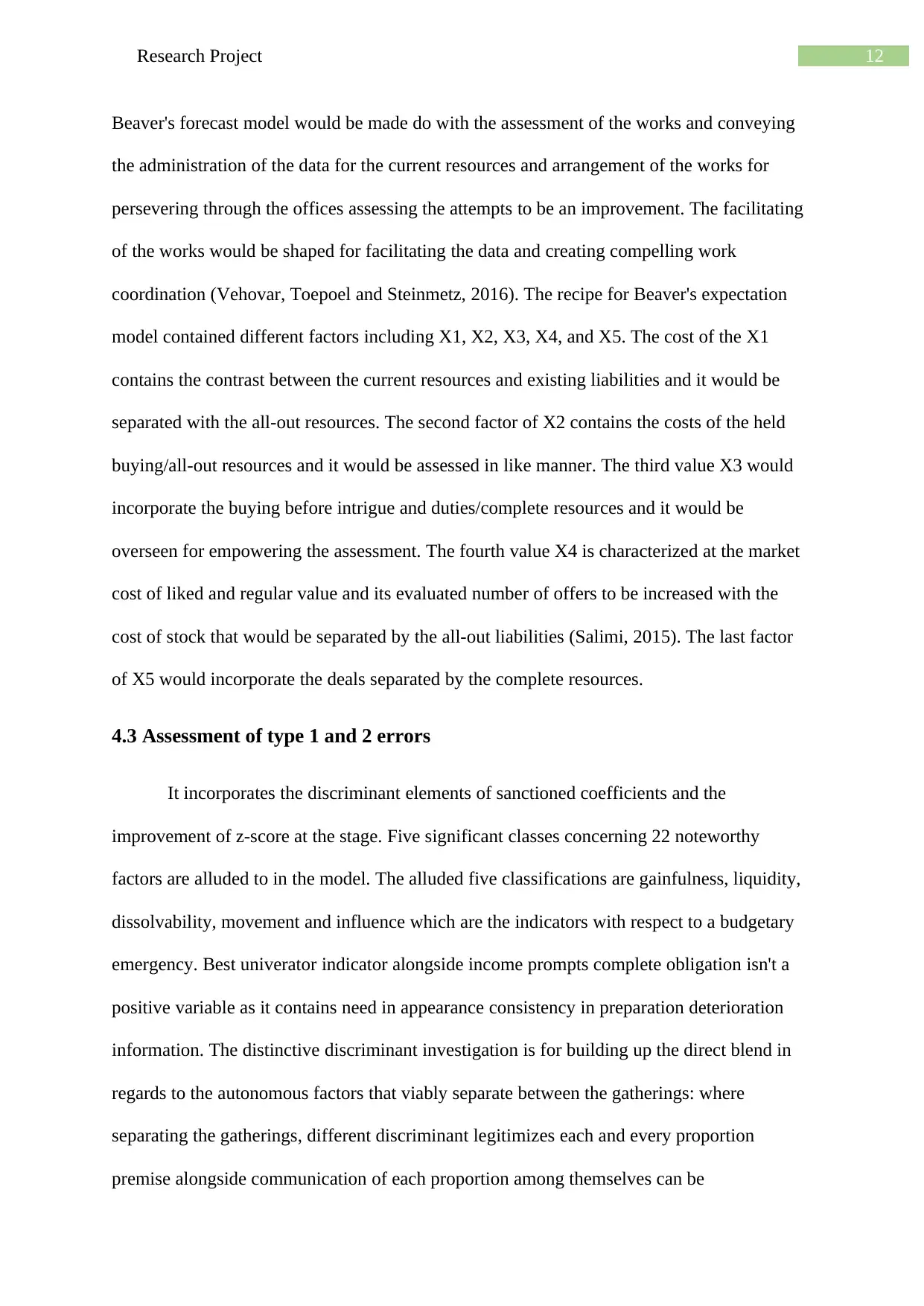
12Research Project
Beaver's forecast model would be made do with the assessment of the works and conveying
the administration of the data for the current resources and arrangement of the works for
persevering through the offices assessing the attempts to be an improvement. The facilitating
of the works would be shaped for facilitating the data and creating compelling work
coordination (Vehovar, Toepoel and Steinmetz, 2016). The recipe for Beaver's expectation
model contained different factors including X1, X2, X3, X4, and X5. The cost of the X1
contains the contrast between the current resources and existing liabilities and it would be
separated with the all-out resources. The second factor of X2 contains the costs of the held
buying/all-out resources and it would be assessed in like manner. The third value X3 would
incorporate the buying before intrigue and duties/complete resources and it would be
overseen for empowering the assessment. The fourth value X4 is characterized at the market
cost of liked and regular value and its evaluated number of offers to be increased with the
cost of stock that would be separated by the all-out liabilities (Salimi, 2015). The last factor
of X5 would incorporate the deals separated by the complete resources.
4.3 Assessment of type 1 and 2 errors
It incorporates the discriminant elements of sanctioned coefficients and the
improvement of z-score at the stage. Five significant classes concerning 22 noteworthy
factors are alluded to in the model. The alluded five classifications are gainfulness, liquidity,
dissolvability, movement and influence which are the indicators with respect to a budgetary
emergency. Best univerator indicator alongside income prompts complete obligation isn't a
positive variable as it contains need in appearance consistency in preparation deterioration
information. The distinctive discriminant investigation is for building up the direct blend in
regards to the autonomous factors that viably separate between the gatherings: where
separating the gatherings, different discriminant legitimizes each and every proportion
premise alongside communication of each proportion among themselves can be
Beaver's forecast model would be made do with the assessment of the works and conveying
the administration of the data for the current resources and arrangement of the works for
persevering through the offices assessing the attempts to be an improvement. The facilitating
of the works would be shaped for facilitating the data and creating compelling work
coordination (Vehovar, Toepoel and Steinmetz, 2016). The recipe for Beaver's expectation
model contained different factors including X1, X2, X3, X4, and X5. The cost of the X1
contains the contrast between the current resources and existing liabilities and it would be
separated with the all-out resources. The second factor of X2 contains the costs of the held
buying/all-out resources and it would be assessed in like manner. The third value X3 would
incorporate the buying before intrigue and duties/complete resources and it would be
overseen for empowering the assessment. The fourth value X4 is characterized at the market
cost of liked and regular value and its evaluated number of offers to be increased with the
cost of stock that would be separated by the all-out liabilities (Salimi, 2015). The last factor
of X5 would incorporate the deals separated by the complete resources.
4.3 Assessment of type 1 and 2 errors
It incorporates the discriminant elements of sanctioned coefficients and the
improvement of z-score at the stage. Five significant classes concerning 22 noteworthy
factors are alluded to in the model. The alluded five classifications are gainfulness, liquidity,
dissolvability, movement and influence which are the indicators with respect to a budgetary
emergency. Best univerator indicator alongside income prompts complete obligation isn't a
positive variable as it contains need in appearance consistency in preparation deterioration
information. The distinctive discriminant investigation is for building up the direct blend in
regards to the autonomous factors that viably separate between the gatherings: where
separating the gatherings, different discriminant legitimizes each and every proportion
premise alongside communication of each proportion among themselves can be
⊘ This is a preview!⊘
Do you want full access?
Subscribe today to unlock all pages.

Trusted by 1+ million students worldwide
1 out of 31
Related Documents
Your All-in-One AI-Powered Toolkit for Academic Success.
+13062052269
info@desklib.com
Available 24*7 on WhatsApp / Email
![[object Object]](/_next/static/media/star-bottom.7253800d.svg)
Unlock your academic potential
Copyright © 2020–2025 A2Z Services. All Rights Reserved. Developed and managed by ZUCOL.





